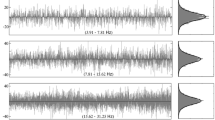Summary
In a previos study (Harmony et al. 1993) we observed that the volume of lesions was correlated only with delta power, while the volume and density of edema showed a significant correlation with theta and alpha power, suggesting two independent origins of activity in the delta and theta bands in patients with space-occupying lesions. Our goal in this paper is to show, through a different technique, in a narrow band spectral analysis, that brain lesions are characterized by activity in the delta domain and that edema is better correlated with activity within the theta range. Frequency source analysis based on the Maximum Likelihood (ML) test for rejection of isotropicity was applied to the EEG at rest of 36 patients with space-occupying intracranial lesions. The ML test was rejected at frequencies below 1 Hz and in the low range of the delta rhythm in 31 patients. The origin of the equivalent dipoles at these frequencies was within the volume of the lesion in 27 patients. In IS patients out of 19 with vasogenic edema the ML test was rejected at frequencies in the theta range. The equivalent dipoles at these frequencies were all within the volume of the edema.
Similar content being viewed by others
References
Ball, G.J., Gloor, P. and Schaul, N. The cortical microphysiology of pathological delta waves in the electroencephalogram of cats. Electroenceph. clin. Neurophysiol., 1977, 43: 346–361
Brillinger, D.R. Time series: data analysis and theory. Holt, Rinehart and Winston, Inc. 1975, pp. 160–166.
Burg, J.P., Luenberger, D.G. and Wenger, D.L. Estimation of structure covariance matrices. Proc. IEEE, 1982, 70: 963–974.
Duffy, F.H. The BEAM method for neurophysiological diagnosis. Ann. N. Y. Acad. Sci., 1985, 457: 19–34.
Fender, D.H. Source localization of brain electrical activity. In: A. Gevins, A. Rémond (Eds.). Handbook of Electroencephalography and Clinical Neurophysiology, Revised Series. Vol. 1. Analysis of electrical and magnetic signals, Elsevier, Amsterdam, 1987: 355–403.
Gloor, P., Ball, G. and Schaul, N. Brain lesions that produce delta waves in the EEG. Neurology, 1977, 27: 326–333.
Goldensohn, E.S. Use of the EEG for the evaluation of focal intracranial lesions. In: D.W. Klass and D.D. Daly (Eds.), Current practice of electroencephalography. Raven Press, New York, 1979: 307–341.
Harmony, T., Fern∧andez-Bouzas, A., Marosi, E., Fernandez, T., Bernal, J., Rodriguez, M., Reyes, A., Silva, J., Alonso, M. and Casian, G. Correlation between computed tomography and voltage and current source density spectral EEG parameters in patients with brain lesions. Electroenceph. clin. Neurophysiol., 1993, 87: 196–205.
Lehmann, D. Principles of spatial analysis. In: A. Gevins and A. Rémond (Eds.). Handbook of Electroencephalography and Clinical Neurophysiology, Revised Series. Vol. 1. Analysis of electrical and magnetic signals, Elsevier, Amsterdam, 1987: 309–354.
Lehmann, D. and Michel, C.M. Intracerebral dipole sources of EEG FFT power maps. Brain Topography, 1989, 2: 155–164. (Erratum: 1990, 2: 311.)
Lehman, D. and Michel, CM. Intracerebral dipole source localization for FFT power maps. Electroenceph. clin. Neurophysiol., 1990, 76: 271–276.
Lutkenhoner, B. Frequency-domain localization of intracerebral dipolar sources. Electroenceph. clin. Neurophysiol., 1992, 82: 112–118.
Nuwer, M.R. Quantitative EEG. II Frequency analysis and topographic mapping in clinical settings. J. Clin. Neurophysiol., 1988, 5: 45–85.
Petsche, H., Pockberger, H. and Rappelsberger, P. On the search for the sources of the electroencephalogram. Neuroscience, 1984, 11: 1–27.
Prichep, L.S. and John, E.R. QEEG profiles of psychiatric disorders. Brain Topography, 1992, 4: 249–257.
Scherg, M. Fundamentals of dipole source potential analysis. In: F. Grandori, M. Hoke and G.L. Romani (Eds.). Auditory Evoked Magnetic Fields and Electric Potentials. Advances in Audiology. Vol. 6. Karger, Basel, 1990: 40–69.
Siotani, M., Takesi, H. and Yasunori, F. Modern multivariate statistical analysis: a graduate course and handbook. American Science Press, Inc., Columbus, 1983.
Steriade, M., Nuñez, A. and Amzica, F. A novel slow (<1 Hz) oscillation of neocortical neurons in vivo: depolarizing and hyperpolarizing components. J. Neuroscl., 1993a, 13: 3252–3265.
Steriade, M., Nuñez, A. and Amzica, F. Intracellular analysis of relations between the slow (<1 Hz) neocortical oscillation and other sleep rhythms of the electroencephalogram. J. Neuroscl., 1993b, 13: 3266–3283.
Steriade, M., Contreras, D., Curro-Dorsi, R. and Nuñez, A. The slow (<1 Hz) oscillation in reticular thalamocortical neurons: scenario of sleep rhythm generation in interacting thalamic and neocortical networks. J. Neuroscl., 1993c, 13: 3284–3299.
Silberstein, R.B. and Cadusch, P.J. Measurement processes and spatial principal component analysis. Brain Topography, 1992, 4: 267–276.
Valdés, P., Bosch, J., Grave, R., Hernandez, J., Riera, J., Pascual, R. and Biscay, R. Frequency domain models of the EEG Brain Topography, 1992, 4: 309–319.
Author information
Authors and Affiliations
Additional information
This study was supported in part by DGAPA, UNAM, Project IN202492.
Rights and permissions
About this article
Cite this article
Harmony, T., Fernández-Bouzas, A., Marosi, E. et al. Frequency source analysis in patients with brain lesions. Brain Topogr 8, 109–117 (1995). https://doi.org/10.1007/BF01199774
Accepted:
Issue Date:
DOI: https://doi.org/10.1007/BF01199774




